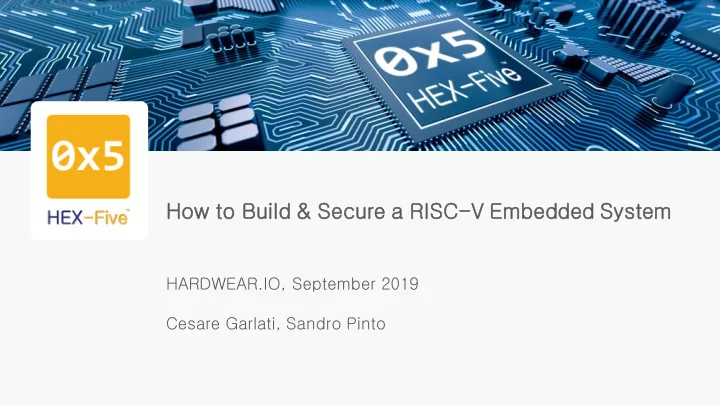

Ho How w to o Bui Build & Secur cure a RISC-V Em Embe bedde ded System HARDWEAR.IO, September 2019 Cesare Garlati, Sandro Pinto
RISC-V ISA Security Building Blocks Privi vilege lege Levels vels & Contro rol l and Status Registers ers Phys ysical l Memory y Protec ection ▪ Machine – always present, highest privilege mode ▪ Hardware enforced – 4 ranges * 4 config reg (if implemented) ▪ ▪ Supervisor – Linux, supports MMU / virtual memory Policy R/W/X => synchronous exception mechanism (trap) ▪ Reserved (Hypervisor) – work in progress ▪ Overlapping OK, ranges can be locked down ▪ ▪ User / Application – unprivileged lowest level Top of range (TOR) or naturally aligned power of two (NAPOT) ▪ ▪ Trusted Execution Environment runs at highest privilege Trusted Execution Environment manages PMP context at runtime ▪ Note: enforced per core – no ISA spec for multi-core / platform Note: Interrupts always M mode (unless “N” implemented) ▪ Rings Modes Intended Usage A Name Description 1 M Unsecured embedded 1 TOR Top of range 2 M,U Secure embedded 2 NA4 Naturally aligned 4-byte 3 M,S,U Linux 3 NAPOT Naturally aligned power of 2
Download Resources https://hex-five.com/download/
Download Resources- GitHub https://github.com/hex-five/multizone-sdk
HEX-Five X300 SoC – ARTY7 FPGA The X300 is developed and maintained by Hex Five to support MultiZone IoT applications. The X300 SoC is an enhanced version of the Freedom E300 Platform based on the original Rocket Chip developed at U.C. Berkeley and now maintained by SiFive. The X300 is completely open source and free of charge for commercial and non-commercial use. GitHub hex-five/multizone-fpga
MultiZone™ Security – How It Works Zone 1 Binary Tick = 10 # ms (ELF/HEX) Zone = 1 irq = 16 # BTN0 Zone 2 base = 0x20410000; size = 64K; rwx = rx # FLASH Binary base = 0x80001000; size = 16K; rwx = rw # RAM (ELF/HEX) base = 0x10025000; size = 0x100; rwx = rw # PWM base = 0x10012000; size = 0x100; rwx = rw # GPIO base = 0x0C000000; size = 0x400000; rwx = rw # PLIC Zone 3 Binary Secure Hex Five Zone = 2 (ELF/HEX) irq = 17, 18 # BTN1, BTN2 Boot Tool Chain base = 0x20420000; size = 64K; rwx = rx # FLASH base = 0x80005000; size = 16K; rwx = rw # RAM Zone 4 Extension Firmware base = 0x60000000; size = 8K; rwx = rw # XEMACLITE Binary (ELF/HEX) Zone = 3 base = 0x20430000; size = 64K; rwx = rx # FLASH base = 0x80009000; size = 4K; rwx = rw # RAM nanoKernel Zone = 4 base = 0x20440000; size = 64K; rwx = rx # FLASH base = 0x8000A000; size = 4K; rwx = rw # RAM base = 0x10013000; size = 0x100; rwx = rw # UART Policies (multizone.cfg) Patent pending US 16450826, PCT US1938774 - Configuring, Enforcing, And Monitoring Separation Of Trusted Execution Environments.
MultiZone™ Open Standard API – C Library Permissive Licensing – “any purpose” Hardware threads (zones) management Inter zone messaging – zone0 SMP Linux Traps & IRQs handlers registration (U-mode) Traps & IRQs enable / disable – per zone Hardware thread timer – per zone Trap & emulation helpers Read-only, selected CSRs Completely optional – just for speed / latency
Reference Application - Secure IoT Stack Zone #2 Zone #3 Zone #4 Zone #1 Crypto TEE Console TLSv1.3, Cipher TLS_AES_128_GCM_SHA256 RTOS TCP/IP Root of Trust Peer signing digest: SHA256 U-mode Apps Peer signature type: ECDSA [FreeRTOS] [picoTCP] [wolfSSL] [MultiZone] Server Temp Key: ECDH, P-256, 256 bits Server public key is 256 bit Private Key ASN1 OID: prime256v1 U-mode IRQs GPIO / IRQs ETHERNET OTP / FUSE / PUF UART Private Key NIST CURVE: P-256 InterZone™ Secure Communications M-mode MultiZone™ Secure nanoKernel PMP Hardware ARTY FPGA - Rocket RV32 IMACU SPI / USB Internet TLS 1.3 / ECC UART
™ For Linux – Enclave Concept MultiZone Hardware-enforced Software-defined Boundaries Enclave #2 Enclave #3 Enclave #4 Enclave #1 U-mode Linux User Land Apps Linux User Land Apps Linux User Land Apps Linux User Land Apps App App App App 4 x SMP Linux 4 x SMP Linux S-mode 4 x SMP Linux [bare metal] [bare metal] [bare metal] [bare metal] 4 x SMP Linux MultiZone TM IPC Driver Ethernet Driver MultiZone TM IPC Driver Ethernet Driver MultiZone TM IPC Driver Ethernet Driver MultiZone TM IPC Driver Ethernet Driver UART Driver PWM LED Driver M-mode MultiZone TM IPC MultiZone TM IPC MultiZone™ Secure Communications MultiZone TM IPC MultiZone TM IPC IPC MultiZone TM nanoKernel SiFive U54 (RV64 IMACFU) PMP HW SiFive U54 (RV64 IMACFU) SiFive U54 (RV64 IMACFU) SiFive U54 (RV64 IMACFU) SiFive E51 (RV64 IMACU) Multiple statically defined enclaves – ram, rom, i/o, irq Secure messaging with no shared mem - secure buffers for Linux IPC Secure interrupt handlers mapped to enclaves and executed in U-mode Trap & emulation of privileged instructions, Soft-timers, Secure boot
tiZone ™ Secur Hex x Five ve Mu Multi ecurity Hex Five Security, Inc. is the creator of MultiZone™ Security, the first Trusted Execution Environment for RISC -V. Hex Five open standard technology provides software-defined hardware-enforced separation for multiple security domains, with full isolation of data, programs and peripherals. Contrary to traditional solutions, MultiZone™ Security requires no additional hardware or changes to existing software: open source libraries, third party binaries and legacy code can be configured in minutes to achieve unprecedented levels of safety and security.
Recommend
More recommend